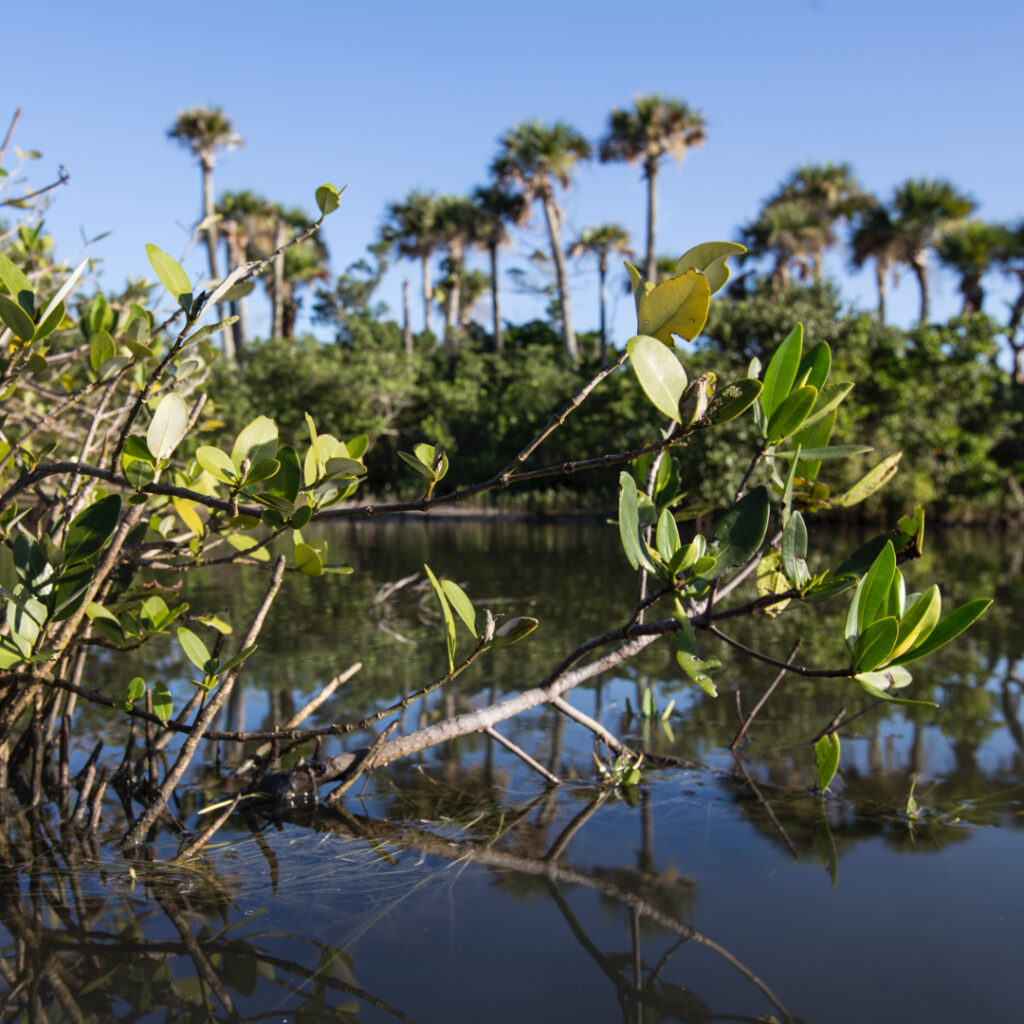
Mangroves along the banks of the Indian River Lagoon. Photo by Tyler Jones, UF/IFAS.
Florida Sea Grant celebrates the annual International Day for the Conservation of the Mangrove Ecosystem, highlighting the importance of mangrove ecosystems and to promote solutions for their sustainable management, conservation and uses. This International Day was adopted by the General Conference of the UN Educational, Scientific and Cultural Organization (UNESCO) in 2015.
“Snorkel Roots”, “Walking Trees”, and “Guardians of the Coast” sound like the names that belong to species from a fictional fantasy realm, but believe it or not, these are the nicknames for a not-so-distant tree right in our coastal backyard: mangroves! With more than 80 species of mangroves worldwide, three are native to Florida including the red mangrove (Rhizophora mangle), black mangrove (Avicennia germinans), and white mangrove (Laguncularia racemosa).
What makes these salty, tangled-root trees so significant to our coastal ecosystem?
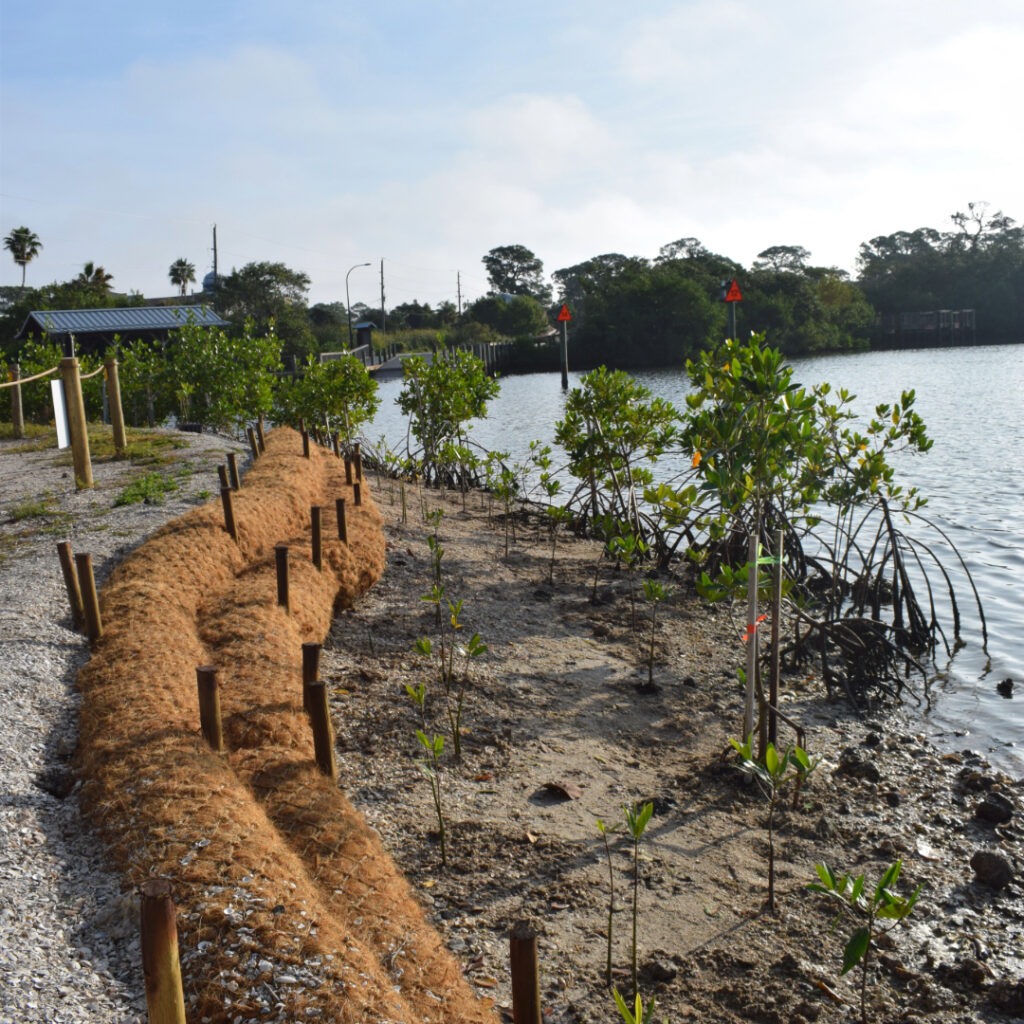
Mangrove used as a living shoreline element. Photo by Armando Ubeda.
Mangroves are vital to coastal environments, providing many ecological benefits. The complex root system of mangrove filters through pollutants and the tree captures more carbon than seagrass and even rainforests, overall improving water quality. Mangroves also provide an amazing habitat and food web for bird species, terrapins, invertebrates, and fish including goliath grouper, snook, snapper, tarpon, jack, sheepshead, red drum, juvenile lobsters, oyster, and shrimp.“In our area, nearly 80-85% of fish that we use recreationally and commercially are associated with mangroves,” says Armando Ubeda, Florida Sea Grant UF/IFAS Extension Agent for Sarasota County.
On top of all of this, mangroves play a key role in erosion control and shoreline stabilization. Due to their dense roots, mangroves are integrated into one of the most current and popular nature-based innovations otherwise known as living shorelines.
“Throughout Florida, mangroves are an integral feature in living shorelines. With erosion and storm surge events happening near estuaries and coastal bodies of water, it makes sense to use the existing natural elements like mangroves in those areas,” says Ubeda.
Living shorelines are a form of green infrastructure that uses natural elements to control erosion, and support various ecological services that might have been lost by altering the shoreline through gray infrastructure including food production, nutrient and sediment removal, and water quality improvement. The fortification and stability of mangroves, particularly red mangroves, which grow closest to the water, help buffer the shoreline and minimize flooding and erosion.
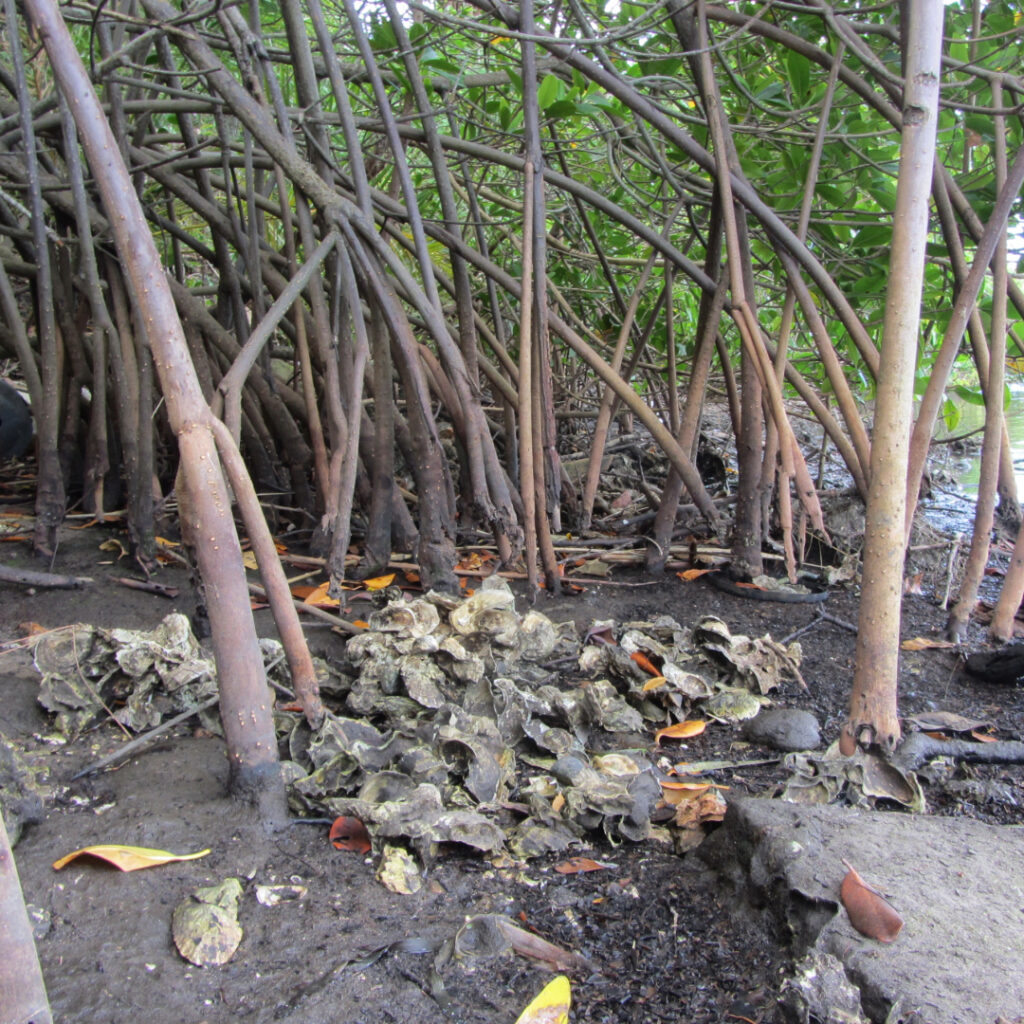
Oysters growing alongside mangrove prop roots. Photo by Armando Ubeda.
“In South Florida, where I am, we have coral reefs offshore as the first natural barrier during major storms. Inland from the reefs, we have seagrasses that help slow down waves. By the time the water reaches the shore, it encounters mangroves, which further protect the land.” says Ana Zangroniz, Florida Sea Grant UF/IFAS Extension Agent for Miami-Dade County.
Living shorelines require efficient design based on the pressures associated with the site and the different elements that can be combined to allow stabilization to happen quickly. Some living shorelines use a sort of breakwater structure, such as a reef ball or plastic-free oyster reef prisms, which are structures made out of different types of material from the base of new oyster reefs. Mangroves can be planted within or between these structures to protect the mangrove until it is fully developed. Once that mangrove is developed, it can provide other ecological services to surrounding vegetation and coastal
“Having multiple elements in the design of living shorelines allows us to see the natural succession of organisms,” says Armando Ubeda. “Once those roots are fully developed, the mangrove is then able to provide a surface for all these filter feeders like oysters to grow into.”
Throughout Florida, mangroves are an integral feature in living shorelines. With erosion and storm surge events happening near estuaries and coastal bodies of water, it makes sense to use the existing natural elements like mangroves in those areas.
Armando Ubeda
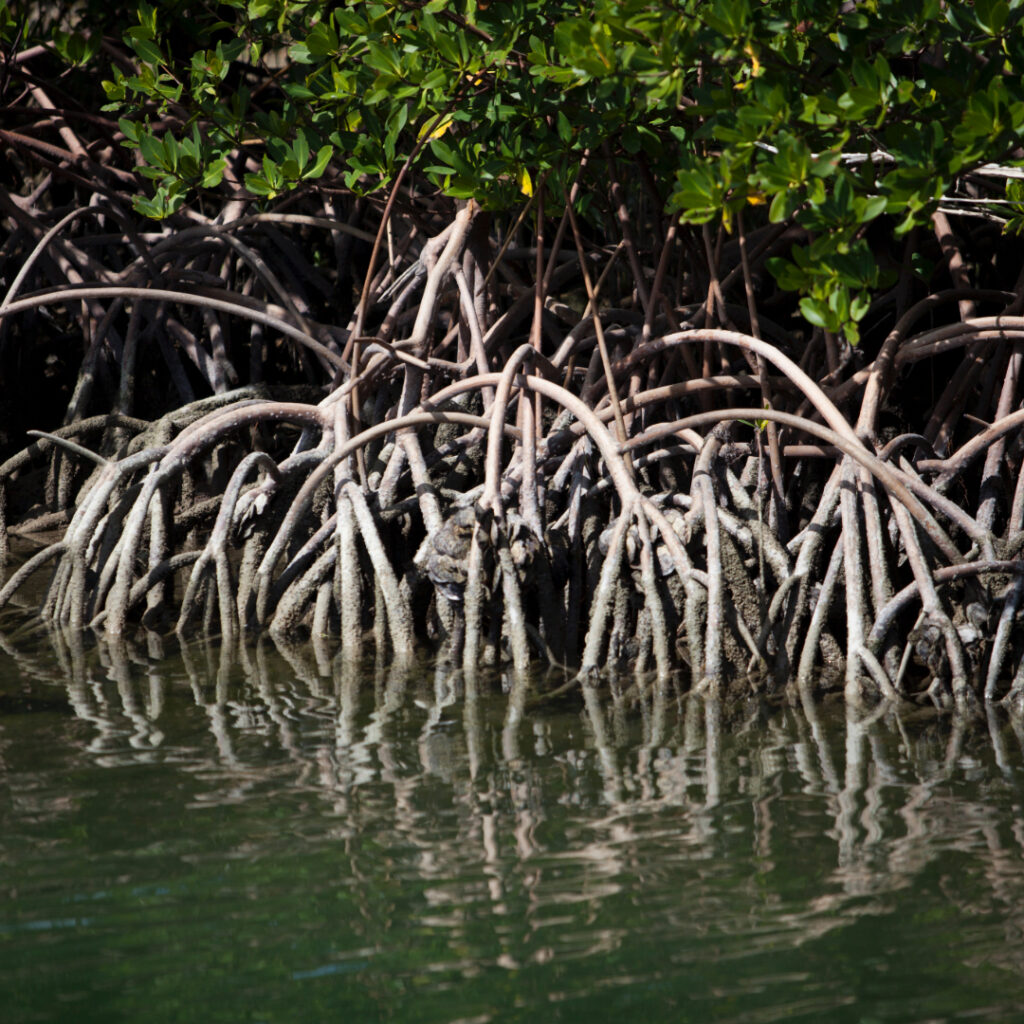
Mangroves in Biscayne Bay. Image by Amy Stuart, UF/IFAS.
What morphological features support the use of mangroves in living shorelines?
“Black mangrove roots are similar to seagrass root systems. These roots can be quite extensive, reaching two to three feet long, and are connected to a horizontal root system,” says Zangroniz. “Red mangroves have prop roots that extend from the tree down into the water, creating a dense network both above and below the water’s surface. Black mangroves, on the other hand, have a submerged cable root system with roots called pneumatophores that protrude into the air, acting like snorkels to facilitate oxygen and gas exchange.”
Mangrove roots stabilize the surrounding sediment deposits and soil and are effective at trapping leaves, which decompose and result in stronger shorelines over time. Alongside their ability to enforce stabilization, mangroves are easier to grow compared to other plants. Mangroves are viviparous, meaning seeds germinate or develop while they are still on the tree. The resulting propagule is dispersed with gravity and water, and they are ready to take root once a suitable habitat is encountered.
How can I ensure the protection of mangroves?
Besides spotting mangroves at a designated shoreline area, mangrove swamps can typically be found in salty or brackish water, along bays, estuaries, and rivers; they can grow in freshwater but face more competition. Sometimes in Florida, mangrove swamps occur along the shores of the peninsula, on the leeward side of barrier islands, and the Florida Keys. Some of the largest mangrove communities in Florida occur in the Ten Thousand Island area.
However, warmer ocean waters and more frequent and stronger tropical storm activity has helped the spread of mangrove seed or “propagules”. Mangroves have been slowly migrating northward in Florida, on both the Atlantic and Gulf coasts. From the early 1990’s, researchers began to find mangroves in both Cedar Key and Cape Canaveral.
Despite the migration of the salty tree into northern portions of the state, Florida has lost 84% of its historical mangrove populations since the 1940s, particularly in the Indian River Lagoon. This loss is largely due to human activity, especially the clear-cutting of mangroves for coastal development during the state’s rapid growth in the 1940s and 1950s. As people built homes and businesses along the coast, mangroves were removed.
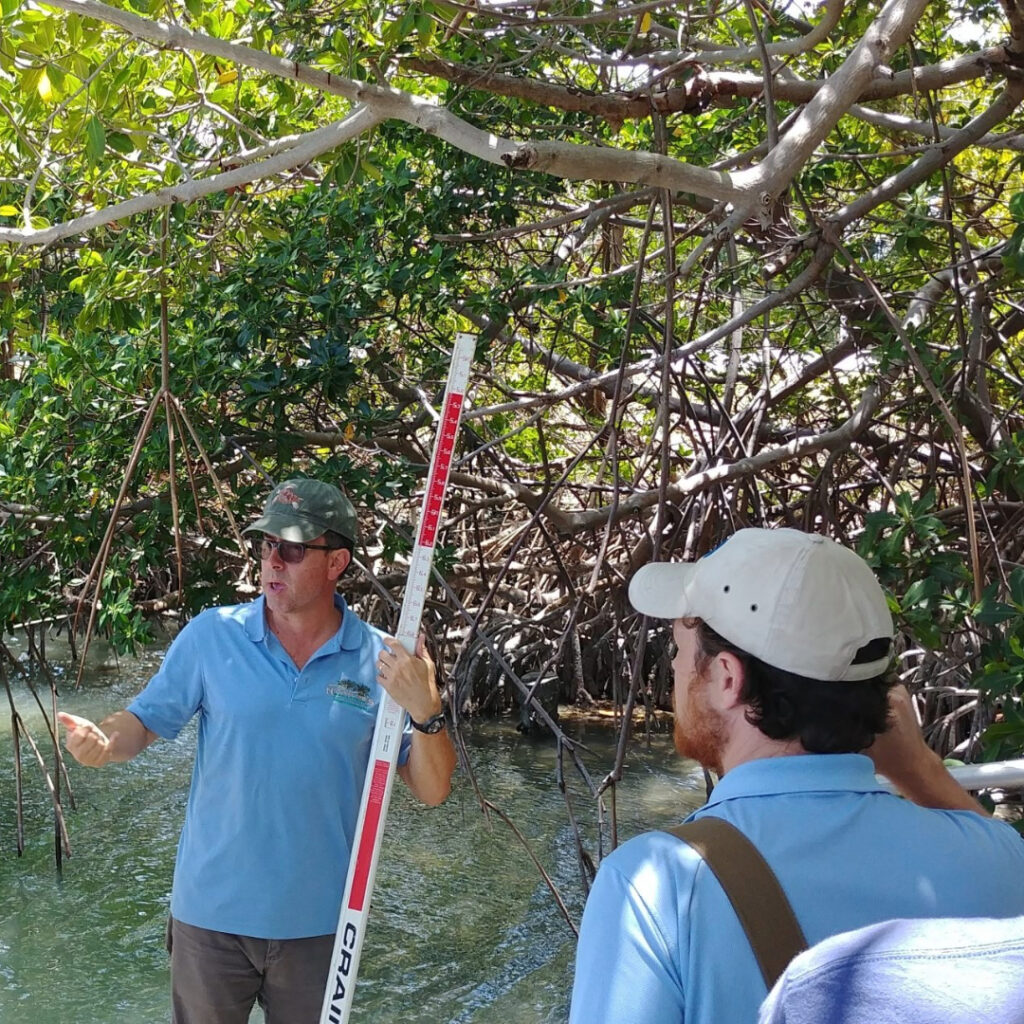
Eduardo Salcedo, center, of Miami-Dade County’s Natural Areas Management teaches how to determine proper maintenance trimming height. Photo by Ana Zangroniz.
“Reintroducing mangroves is challenging because once they are removed, it’s difficult for them to reestablish and grow properly,” says Zangroniz.
To address this, Florida enacted the Mangrove Trimming and Preservation Act in 1990, revised in 1996, which regulates mangrove trimming. A permit may need to be obtained to remove any part of a mangrove tree on private property. Professional Mangrove Trimmers (PMTs) can perform such trimming activities and ensure no regulations are violated. To maintain their respective licenses, PMTs and other horticultural professionals must participate in professional development opportunities and earn Continuing Education Units (CEUs). In partnership with other organizations, UF/IFAS Extension and Florida Sea Grant now offer both in-person and virtual mangrove trimming workshops on mangrove biology and ecology, mangrove ecological function and ecosystem services, the Mangrove Protection Trimming Act (MPTA), and best practices for mangrove trimming. Those who participate in the courses can obtain a Continuing Education Unit (CEU).
“Improper trimming or pruning can kill the trees, so guidelines are based on best management practices for horticulture to keep the trees healthy. It is also important to note that mangroves have a remarkable ability to sequester carbon, not only in their trunks and branches but also in their leaves and roots, making the entire tree a vital part of carbon storage, so removing an entire mangrove would do further harm than good.” says Zangroniz.
Many ecological communities depend on these salty shrubs for survival, and our coastal landscape is supported by its unique stabilization features. The future of mangrove health depends on our education and action.
“Mangroves are extremely critical in protecting us against natural disasters, and maintaining healthy ecosystems, the wellbeing for communities, and a healthier economy. They provide a lot of ecological services that are completely necessary to us and the environment,” says Ubeda.
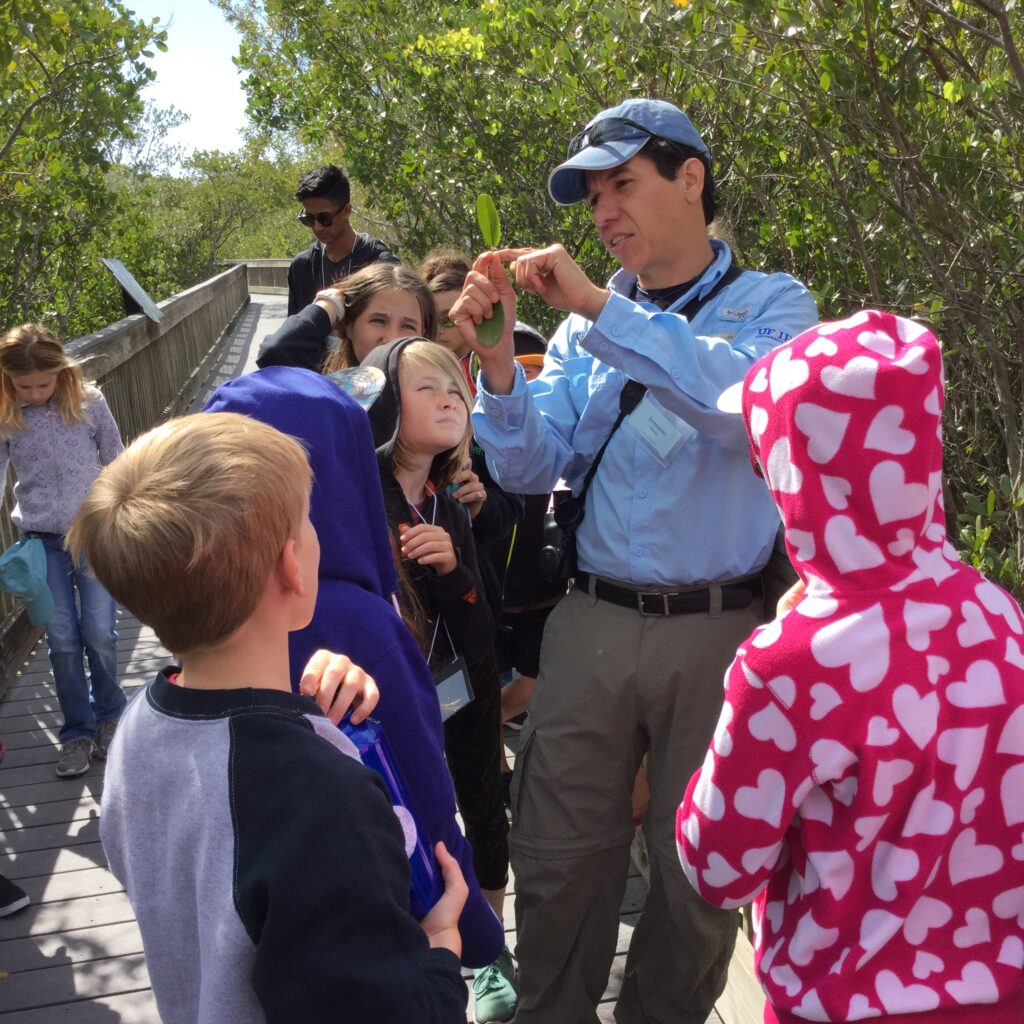
Armando Ubeda leading an EcoWalk tour of mangrove in Sarasota County. Photo by Armando Ubeda.
For more training and educational resources related to mangroves, check out the resources below.
Find a State Authorized Professional Mangrove Trimmer (PMT’s): https://floridadep.gov/water/submerged-lands-environmental-resources-coordination/content/state-authorized-professional
Mangrove Trimming Workshop: Contact Ana Zangroniz for trainings on the Atlantic coastal area at [email protected]. Contact Armando Ubeda for trainings on the Gulf Coast area at [email protected].
Read the Mangrove Preservation Trimming Act: https://floridadep.gov/water/submerged-lands-environmental-resources-coordination/documents/mangrove-trimming-and
Learn more and register for a Living Shorelines Training for Marine Contractor: https://www.flseagrant.org/workforce-training/living-shorelines-training-for-marine-contractors/
Join UF/IFAS Sarasota County Agent, Armando Ubeda, in an upcoming EcoWalk, a tour of mangroves surrounding local natural areas: https://www.eventbrite.com/e/ecowalk-mangroves-registration-893724763827?aff=ebdsoporgprofile, or check out the county calendar for more events: https://www.eventbrite.com/o/ufifas-extension-sarasota-county-422952084.